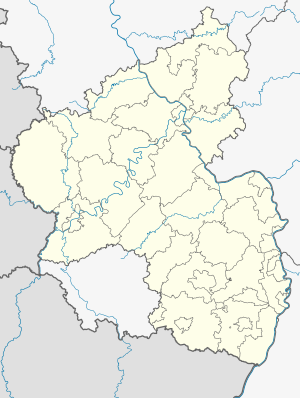Flohr Neuwied biomass cogeneration plant
| CHP Flohr | |||
|---|---|---|---|
| Flohr Neuwied biomass cogeneration plant | |||
| location | |||
|
|
|||
| Coordinates | 50 ° 26 '42 " N , 7 ° 27' 36" E | ||
| Data | |||
| Primary energy | Bioenergy | ||
| fuel |
Waste wood A1-A4 (+ natural gas for safety boiler) |
||
| power | 7.6 MW (electrical) + process steam | ||
| owner |
Evonik New Energies Spedition Flohr |
||
| operator | BHKW Flohr GmbH | ||
| Start of operations | 2005 | ||
| turbine |
Steam turbine (B + V Industrietechnik) |
||
| cooling | Air condenser ( GEA ) | ||
| boiler | 3-pull, vertical (WULFF) | ||
| Firing | Grate furnace (WULFF) | ||
| Exhaust gas cleaning | SNCR , cyclone , absorber , bag filter (WULFF) | ||
| Website | http://www.flohr.de | ||
The Flohr CHP is a biomass cogeneration plant in Neuwied that is fired with waste wood .
It stands on the site of the thin-sheet Rasselstein of ThyssenKrupp AG and supplied it with process steam. The CHP replaces two old gas / oil-fired steam boilers in the sheet metal works.
Furthermore, electrical energy is generated according to the power-heat coupling principle and fed into the RWE network.
The biomass cogeneration plant is a joint project between STEAG Saar Energie and the Neuwied-based forwarding company Flohr, which specializes in trading in waste wood .
Technical structure and function
The biomass cogeneration plant essentially consists of:
- Wood storage and processing
- The plant recycles more than 60,000 tons of waste wood of classes A1 to A4 per year in accordance with the waste wood ordinance . It has a catchment area of approx. 100 km radius. The wood is delivered by truck, temporarily stored on an 8000 m² site, shredded to approx. 30–50 cm in a shredder and then fed to the furnace via a moving floor system and an inclined conveyor.
- Firing with steam boiler
- Firing and steam boiler form a structural unit (manufacturer: Wulff Germany ). The furnace is a grate furnace with a moving grate . The resulting flue gases leave the furnace at a temperature> 850 ° C and enter the steam generator . On the flue gas side, the boiler is a vertical boiler with three puffs; water side an indentation natural circulation -boiler without reheating of about 32 t / h steam supplies.
- Flue gas cleaning and chimney
- The system is equipped with a modern flue gas cleaning system according to the 17th BImSchV (manufacturer: Wulff Germany ). A non-catalytic denitrification ( SNCR ) using urea is integrated in the boiler . The dedusting consists of a cyclone separator for coarse dust and a fabric filter ( bag filter ) for fine dust. In between there is an absorber reactor based on dry lime hydrate . This binds sulfur and other pollutants. The cleaned flue gases are guided to the 45 m high chimney by an induced draft fan . Separated dust and adsorbents are temporarily stored in silos and transported away by truck.
- Steam turbine with air-cooled condenser
- The steam coming from the boiler is converted into electrical energy in a condensing steam turbine (manufacturer: B + V Industrietechnik , today: MAN Turbo ). The maximum electrical output is approx. 7.6 MW .
- The steam is condensed in an air condenser (manufacturer: GEA ) and fed back into the boiler.
- Auxiliary boiler system and process steam supply
- In normal operation, the process steam is drawn off from an extraction point in the steam turbine. This steam is conducted to the Rasselstein sheet metal works via a pipeline approx. 300 m long. Around 100,000 tons of steam are delivered every year.
- There must also be in the event of a business interruption ensure the process steam supply for the thin-sheet in the biomass combustion, the CHP is to secure two fast bootable, natural gas -befeuerten shell boilers (Manufacturer: Loos ) equipped.
- Water treatment
- In order to replenish the operating losses - above all from the process steam supplied - the CHP has a powerful water treatment system with ion exchangers for the production of fully desalinated feed water .
criticism
The citizens' initiative Heddesdorf / Heddesdorfer Berg was formed against the construction and operation of the biomass cogeneration plant . The citizens' initiative's criticism is primarily directed against the noise and dust pollution emanating from the CHP unit and the associated wood processing plant. Furthermore, the fact is criticized that contaminated types of waste wood of classes A3 and A4 may also be burned in the facility. The citizens' initiative calls for the operating license to be restricted to natural wood of classes A1 and A2 and for additional noise and dust protection measures to be taken.
Individual evidence
- ↑ Archive link ( Memento from March 29, 2008 in the Internet Archive )
- ↑ Archive link ( Memento from September 18, 2012 in the web archive archive.today )
- ↑ Citizens' Initiative Heddesdorf / Heddesdorfer Berg ( Memento from February 11, 2015 in the Internet Archive )


